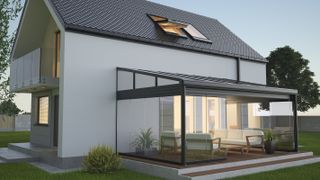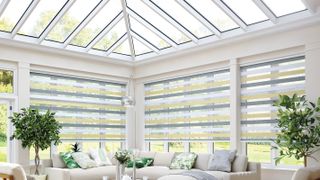How much does a conservatory cost? Our price guide will help you budget for your project
Thinking of getting a conservatory? Our handy price guide explains how much you can expect to pay for uPVC, aluminium and timber frame designs

When considering the options for adding more space to their home, people often think of conservatories first.
They're a great way to increase the footprint of a house, providing a bright and unique space that can be used for a variety of reasons. From traditional conservatories through to orangeries and garden rooms there is an abundance of great conservatory ideas, with popular uses including kitchens, dining rooms and sun lounges.
How you use the extra space is a personal decision, but the fact that conservatory costs are typically lower can make them more appealing than a loft or traditional extension.
Working out your conservatory costs
Conservatory costs are typically lower than extension costs which average at £2,000/m2, while loft conversion costs come in around £1,100/m2. They are also much quicker in terms of build time when compared to either of these options.
However, as there are a number of different types of conservatories, in this cost guide we will look at anticipated costs for each type, as well as pointing out the different factors that could put pressure on your budget.

What affects conservatory costs?
It is possible to pay around £12,000 for a fully installed simple uPVC lean-to conservatory, measuring 3m x 3m. For a hardwood conservatory of the same size and specification, expect to pay upwards of £30,000.
However, the cost of a conservatory will depend on a number of factors which makes it hard to give exact prices. These include:
- Material - uPVC, Aluminium or Timber
- Size and shape - Rectangular, circular or semi-hexagonal
- Glazing - Standard, toughened, solar, low-e, noise-reduction
- Roof - Solid or glazed
- Installation - Professional install or DIY
- Location - Prices will vary depending on where you live
- Planning Permission or Permitted Development - each has different costs
- Additional features - Rooflights, sliding doors, blinds and heating

Although the choice of building materials has the greatest impact on conservatory costs, it is important not to try and save money when it comes to materials.
Your choice will ultimately determine the finished look of your conservatory and, given that this is a structure that will be attached to your house, you don't want to get it wrong. A cheap, flimsy structure could actually devalue your home.
It's also important to remember that the onus is on you to check exactly what is included in your quotation. Choosing offers that look too good to be true may be tempting, but could be a false economy as they frequently leave out important details like dwarf walls, the conservatory base, and the installation procedure.
uPVC conservatory costs
uPVC conservatory costs tend to be the lowest compared to timber and aluminium, which goes a long way towards explaining why uPVC is still the most popular material choice.
If you like the idea of a uPVC conservatory, aim to choose one with a reinforced steel frame, which will ensure it is robust.
Although you might see costs as low as £7,500 for a small, lean-to uPVC conservatory with a polycarbonate roof, full side panels and a pair of French doors, this is likely to be for a DIY kit where you will have to build the base, the foundations and fit it all yourself.
All-inclusive quotations will include foundations, base, brickwork, all materials and full installation.
For a package of this nature, you can expect to pay on average from around £12,142 for a 3 x 3m lean-to with a polycarbonate roof, up to £20,539 for a 4 x 4m Victorian style conservatory with a self-clean solar glass roof (excluding VAT).

Aluminium conservatory costs
Prices for aluminium conservatories vary hugely. Although aluminium is often considered to be a cheaper option than hardwood, this can be misleading when it comes to conservatories, as some striking contemporary glass structures will most certainly exceed the top prices paid for hardwood conservatories.
Nonetheless, aluminium is an excellent material choice because of its thin sight lines, low maintenance requirements, and superb thermal efficiency.
Costs for aluminium conservatories are typically 25% more than those for uPVC conservatories, and will again depend on the style you choose.
Average prices can range from £24,600 for a 4 x 4m Victorian style conservatory with a glass roof, up to £32,000 if you opt for a tiled roof (excluding VAT).

Wooden conservatory costs
The type of timber selected for the frame is the main influencing factor in the cost of a wooden conservatory; softwood is a less expensive option than hardwood.
Wooden conservatories, especially those made of hardwood, are usually the most expensive conservatory type and are also often referred to as orangeries, sunrooms or garden rooms – perhaps putting them in a different arena to uPVC and aluminium conservatories.
But, even though hardwood conservatories made from timber such as oak can initially be more expensive than softwood equivalents, they tend to have greater longevity and require less maintenance, making them a worthwhile investment.
They are also a fantastic way to enhance the architectural aesthetics of period properties or traditional-style homes.
As most timber frame conservatory companies can design to your budget, making them fully bespoke and entirely unique, approximate costs are purely dependant on size and style.
Glasshouse Architecture estimate that, without construction work, the price range for a high-quality oak conservatory is between £2,500 and £3,500/m2. This variance depends on a number of factors, including the design's complexity, degree of detail, and particular requirements.
In the case of a 20m2 oak frame conservatory, the projected cost would be roughly £50,000 but the finer details of the design could impact costs.
“A realistic cost for a 20m2 oak frame extension, whether that be a pitched roof conservatory or a flat roof orangery would be from £3,500 per m2," says George Allen, a design consultant at Oakwrights.
"Our quotations usually include design and planning, the supply and installation of the oak frame, windows, doors and roof and we will work alongside our clients builder who will prepare the foundations and the interior finish. Remember that the cost per m2 square is lower for larger extensions and goes up as extensions decrease in size.”

George has always worked in the oak framing industry and plans to stay there, citing the variety of his role as one of the most enjoyable parts. Taking a client's personality and reflecting it in the end result gives him great satisfaction.

Additional conservatory costs
When calculating your conservatory costs and prices, be sure to factor in the following essential extras:
- Heating - To ensure year-round use and avoid discomfort during the winter months, make sure your conservatory is well-insulated and has a heating system that is effective. Popular methods are electric or wet underfloor heating
- Conservatory flooring - Consider both appearance and useablility
- Window and roof shading - Conservatory blinds should protect furniture and occupants (including pets) from harsh sunlight and assist in temperature control
- Linking to the house - This may require lintels and the accessibility, aesthetics, and the flow between the home and conservatory will also be impacted by the doors that lead from the house into the conservatory
- Decoration - Ensure you budget upfront to achieve the conservatory interior look you desire
- Conservatory lighting - Although you should benefit from daylight, getting the functionality and ambience at night is key
- Electrics - as well as additional outlets and lighting, you may also need it for electrically operated blinds or underfloor heating.
- Building regulation fees - in the case of solid roof conservatories or those bigger than 30m2
- Conservatory planning permission fees - only occasionally required when outside of Permitted Development rights

Checking your conservatory quote
Quotes can be misleading – very cheap quotes are often too good to be true – so it really does pay to ask the following questions when asking for conservatory prices:
- Is installation included?
- What type of doors to outside are included? French, bifold, sliding etc.?
- What specification is the glazing quoted for? Standard, self-cleaning, solar, noise reducing, for example?
- Are groundworks included?
- Is the base construction included?
- Is the construction of any dwarf walls included?
- Is heating included? Bear in mind a conservatory has a heating source separate from the house
- What type of rooflights does the quote include? Automatic or manual?
- Is delivery extra?
FAQs
How much value does a conservatory add to your home?
When looking at ways of adding space to your home - whether it's a garage conversion, a loft conversion idea, extension or conservatory – it's important to consider how much the extra space will add to the overall value of your house.
Even if you're not planning to sell or move in the near future, you'll likely be keen to know that your investment will be worth it.
The additional value of a conservatory will depend on a number of variables, including where you live, the type of house you own and the style and use of your planned addition.
The good news is, in general, a well-built conservatory can increase the value of your house by 5% to 15%, depending on the quality of the construction and the conditions of the local housing market.
But it's important you speak to a local estate agent before you start who can give you an overview of the market. Ceiling prices in your area may mean you could risk out-pricing your property should you ever choose to sell.
Being cautious in this way protects against the possibility of spending on a conservatory that won't add value to your home.
As well as the type of material you choose for the structure of your new conservatory, the style and design you go for will also play a part in fixing the overall cost of your new space.
For a more in-depth look at the costs for different types of conservatories, head to our guides to lean-to conservatory costs and orangery costs.
Get the Homebuilding & Renovating Newsletter
Bring your dream home to life with expert advice, how to guides and design inspiration. Sign up for our newsletter and get two free tickets to a Homebuilding & Renovating Show near you.
Natasha is Homebuilding & Renovating’s Associate Content Editor and has been a member of the team for over two decades. An experienced journalist and renovation expert, she has written for a number of homes titles. Over the years Natasha has renovated and carried out a side extension to a Victorian terrace. She is currently living in the rural Edwardian cottage she renovated and extended on a largely DIY basis, living on site for the duration of the project. She is now looking for her next project — something which is proving far harder than she thought it would be.
- Sarah HarleyAssistant Editor
- Tim Phillips